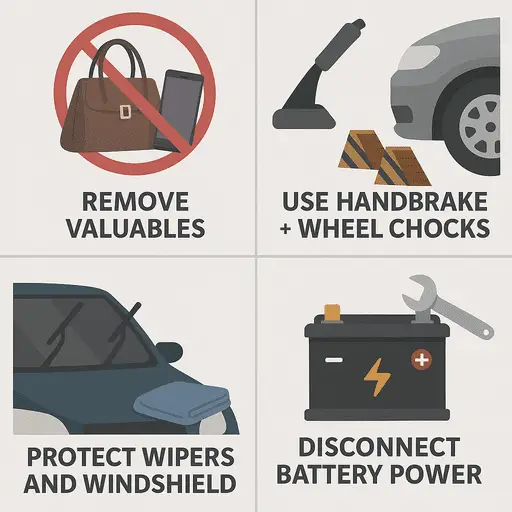Parking your car for an extended period—whether you are traveling, recovering from an injury, or simply do not drive it often—requires more than just locking the doors and walking away.
Vehicles are machines that benefit from regular use. Without proper preparation, a stationary car can quickly develop problems that affect performance, safety, and your wallet.
From battery drain to tire flat spots and unexpected security risks, this guide breaks down four essential things you should always do before leaving your car unused for days or weeks at a time.
1. Remove All Valuables from the Car
The longer your vehicle is left unattended, the more it becomes a target for opportunistic thieves. It is not just about expensive items—something as small as a charging cable or a bag on the seat can tempt someone to break a window.
But there is another reason to remove valuables: temperature damage. Electronics with batteries, cosmetics, or even canned drinks can suffer or explode under fluctuating heat and cold.
Pro Tip: Store your vehicle in a secure garage when possible. If not, keep the interior clear of any visible items and activate any anti-theft devices you have.
2. Use the Handbrake—But Add Wheel Blocks for Safety
It is good practice to use the handbrake (or electronic parking brake) when parking. However, if your car will sit for more than a week, relying on the brake alone can be risky.
In certain conditions, especially with drum brakes or humid environments, the brake components may corrode and stick. This can result in seized brakes the next time you try to drive.
A better solution is to:
- Gently engage the handbrake
- Place rubber wheel chocks or blocks behind the tires to prevent any unintentional movement
Pro Tip: If storing the car on a slope, always face the wheels toward the curb (if on a hill) and use blocks even if the brake is applied. Do not leave the car in gear for long storage—use neutral and secure it with blocks instead.
3. Protect the Windshield Wipers and Glass
Most people overlook the wipers when leaving a car parked for long stretches. But they can become brittle and stick to the windshield, especially under sun exposure or changing temperatures.
Before leaving your vehicle:
- Raise the windshield wipers or place a soft towel beneath them
- Clean the windshield to remove debris, bugs, or film that could damage the blades
- If outside, consider using a windshield cover to shield the glass from UV rays and dirt buildup
These small actions protect both the wiper blades and your windshield from avoidable damage.
Pro Tip: Before returning the vehicle to use, inspect the blades for cracks or stiffness, especially if the car has been idle for over a month.
4. Disconnect Battery Power or Ensure It Stays Charged
One of the most common issues with cars left parked too long is a dead battery. Modern vehicles constantly draw power for systems like the clock, alarm, keyless entry, and infotainment memory—even when turned off.
If your vehicle will sit for more than a week:
- Turn off all lights and electronics before parking
- Ensure dome lights or chargers are not left on
- For 10+ days of non-use, consider disconnecting the battery’s negative terminal
- Alternatively, install a trickle charger or battery maintainer
This prevents you from coming back to a car that will not start.
Pro Tip: When disconnecting the battery, note that some settings in your infotainment or clock may reset. Keep a note of custom presets you may need to re-enter later.
Summary: What to Do Before Parking Long-Term
| Step | Why It Matters | Helpful Tip |
|---|---|---|
| Remove Valuables | Prevents theft and damage from heat or cold | Take items with you or lock them in the trunk |
| Use Handbrake + Wheel Chocks | Reduces the risk of rolling or brake seizure | Use neutral gear and block tires with rubber chocks |
| Protect Wipers and Windshield | Prevents cracking, warping, or sticking | Use a towel under the wipers or lift them up |
| Disconnect or Maintain Battery Power | Prevents battery drain and no-start issues | Use a battery maintainer or disconnect the negative terminal |
Leaving your car parked for an extended time does not need to result in repair bills or frustrating surprises. A few minutes of preparation can protect your investment and ensure your car is ready to drive when you are.
Whether it is for a business trip, vacation, or storing a second vehicle, follow these four steps.

